Spot the queen
Synopsis : Swarmtastic! The first swarms of the season and a timely lesson on why swarm control is important and how clipping the queen really helps.
Introduction
Temperatures have finally achieved a ‘typical’ mid-May average of low teens (°C), and on most days the bees are out foraging well. If anything this is making the discrepancy between the strongest hives and the also-rans even more marked. I’ve just put my fourth supers on some, whereas a few hives are struggling to do anything much with the first one.
The oil seed rape in Fife is going over in a few fields, but most still has 10-14 days to go {{1}} … and the forecast is fantastic, so I’m hoping to still have time to snatch beekeeping victory (or what masquerades as victory for a beekeeper which is full buckets of honey) from the jaws of defeat.
It’s not going to be a bumper spring crop, but it might just about manage average.
I’ll happily take average after my early enthusiasm was so comprehensively dashed a fortnight later.
Of course, the combination of a good nectar flow and overcrowded colonies means that the bees are now busying themselves with swarm preparations. The post today is all about swarms, lost and found, the benefits of clipped queens and the importance of observation.
Or, to put it another way, more tales of slapstick beekeeping 😉 .
Let’s get the excuses out of the way first
I inspected my colonies in Fife on the 10th of May. All looked OK. Since then ‘life’ had conspired to keep me on the west coast; builders {{2}}, visitors, critical dog-sitting duties and a variety of other unavoidable things meant I couldn’t get back to Fife until Sunday the 21st.
Sunday was woeful.
I visited just one apiary to check a few boxes … no bees flying.
Unsurprising as it was 11°C and threatening rain.
I hefted a few hives to reassure myself that they weren’t going to starve … at least not before the following day when the forecast was predicted to be a little better. Surprisingly, the strongest hives were reassuringly heavy 🙂 .
Rather than open boxes in what were pretty hopeless conditions I loaded a few empty supers into the car for the following day and ran some non-beekeeping errands.
Monday 22nd dawned cold and grey. I had to visit the opticians first thing to collect a new set of glasses (I was struggling to distinguish drones from workers, let alone being able to see eggs) and, while in town, fortified myself with caffeine as the polis {{3}} cleared out the last of the revellers from the night before {{4}}.
And, what with one thing and another, I didn’t get to the apiary until late morning to be greeted by leaden skies, temperatures of 13°C and a few spots of rain … a full 12 days since my last visit.
I guess you know where this is going … 😉 .
Clipped queens and swarming
I usually clip my queens. ‘Clipping’ refers to shortening one of the forewings so that the queen cannot fly strongly, or at all.
Some beekeepers consider this practice is barbaric and are happy to let their colonies swarm freely.
I don’t consider it barbaric or like losing swarms.
Most swarms will perish unless they are hived by a beekeeper (studies from Thomas Seeley show that swarm survival is, at best, ~20%), and swarms cause considerable consternation to members of the public. I’d prefer my swarms don’t die of starvation or disease, and don’t upset civilians, so I clip my queens.
Queen clipping does not stop swarming, but it does stop you losing the swarm.
Since that may not make complete sense, and because it’s relevant to the rest of the post, I’ll describe what usually happens when a colony with a clipped (or unclipped) queen attempts to swarm.
The colony makes swarm preparations which means that they produce queen cells and slim the queen down (causing her to lay fewer eggs) so she can fly more strongly. Typically on a warm, calm and sunny afternoon, the swarm leaves the hive. This happens on or shortly after the day on which the first of the developing queen cells are capped. Poor weather delays things, but once the weather is good enough … off they go!
The swarm is a fantastic sight, with up to 75% of the flying bees and the queen leaving the hive.
It’s almost as good a sight as a swarm arriving in one of your bait hives 🙂 .
Clipped vs. unclipped queens and swarms
An unclipped queen will settle on a nearby branch and the flying bees will eventually huddle around her to form a bivouacked swarm. The scout bees then survey the environment to select a new nest site to which the swarm eventually relocates {{5}}.
In contrast, a clipped queen leaves the hive and crashes ignominiously to the ground as she is unable to fly any distance.
Usually one of two things then happens;
- the queen climbs up the hive stand and either re-enters the hive or (more usually in my experience) settles underneath the floor. The flying bees either return to the hive or cluster underneath with the queen.
- the flying bees abandon the queen and return to the hive, leaving the queen (perhaps with a few stragglers) lying in the grass in front of the hive.
Unfortunately for the clipped queen, her long term survival chances are poor (unless re-hived by the beekeeper).
If she returns to the hive either the bees or – in due course – a virgin queen will do away with her, and if she ends up in the grass she will eventually perish.
The final important point is that queen clipping tends to delay swarming. You can therefore inspect colonies somewhat less frequently. In contrast to an unclipped queen (normally {{6}} swarming about the time the first queen cell is capped), a colony with a clipped queen swarms ‘when the first virgin queen is ready to emerge’ (quoted verbatim from no greater authority than Ted Hooper in Guide to Bees and Honey.).
Nope! … I’ll return to this point later.
Swarms: the good, the bad and the ugly
The three colonies (#3, #34 and #48) in my bee shed are stronger than the half dozen other colonies in the same apiary. Whether this is chance or truly reflects the protection offered by the shed is unclear {{7}}.
On the 10th of May all three were looking great … lots of brood, sufficient space to lay, no charged queen cells and with 2-3 supers each. For the purpose of this post, only my notes for colony #34 from the 10th are really relevant and they were …
One PC + egg, no CQC’s, M&C Q next time!
… meaning there were no CQC (charged queen cells, i.e. queen cells containing royal jelly and a larva), but that there had been a play cup (PC; the earliest form of queen cell) containing an egg. The queen, a late 2022 supersedure, was also not marked or clipped {{8}} and the note was to remind me if I saw her.
The other two colonies were performing well though I also noted that the paint on the queen in #48 was rubbing off and that she needed marking again.
I’ve called these three colonies “the good, the bad and the ugly as they nicely illustrate the benefits of clipping queens, and show what happens if you do … and if you don’t 😉 .
I’ll deal with them in reverse order as, a) it makes for a slightly better story, and b) it was the order I inspected the colonies.
’the ugly’ … colony #34
This colony had swarmed. There were sealed and unsealed queen cells in the brood box, no eggs (easy to determine thanks to the new glasses 🙁 ) and no sign of the swarm. This was the colony with the ‘play cup plus egg’ twelve days earlier, so ample time to make some queen cells and then nothing to stop them going.
Remember, the queen was not clipped.
Mea culpa.
Entirely avoidable had one of three things been done:
- I’d employed swarm control on my last visit. However, perhaps a bit premature as it’s not unusual to see eggs in play cups and for them not to develop into queen cells.
- My return visit hadn’t been 12 days later. With only a one week delay I’d have found charged queen cells and – even if I couldn’t find the queen – would have been able to avert swarming by carefully splitting the box to separate the flying bees off.
- I’d clipped the queen 🙁 … perhaps.
You win some and you lose some.
In my defence, it’s probably only the second or third swarm I’ve lost in the last 60-80 ‘hive years’ (number of hives multiplied by years e.g. 20 x 3), and at least one of the others was also a late season supersedure queen that I failed to find and clip before it was too late.
Of course, it goes without saying that the swarm ignored the bait hive located in the same apiary 🙁 … not unsurprising as most swarms travel at least 250-300 metres.
I removed all the sealed queen cells and left one well-formed, charged queen cell on a marked frame. I can reasonably accurately guesstimate the age of the open cell and so know to within a day or so when the new queen will emerge.
’the bad’ … colony #3
It was slowly warming up.
A small tear in the otherwise still-leaden sky showed a patch of cornflower blue.
I removed my fleece (it had been that cold).
While checking the landing boards on the shed I noticed one bee flying out from underneath the shed.
And then another.
And then one flying back in under the shed.
The shed is wood, with a solid floor supported on bearers standing on the slabbed base. The bees – there were a few now – were at the corner of the shed, closest to the entrance to hive #34 (that I now knew had swarmed).
I tried to look under the shed floor but could see nothing. I pushed my phone underneath and took a photo.
Not much help.
So I puffed a few big billows of smoke under there … and received a distinct roar in return.
There was a swarm under the shed.
This was both good news and bad news.
Good because I’d found it using my Miss Marple-like observational skills, bad because it meant one of the other two colonies in the shed had swarmed {{9}}.
I checked the next closest colony (#3, red arrow) and, sure enough, there were open and sealed queen cells. This colony was headed by a clipped and marked queen. I reasoned that they’d swarmed and she’d ended up crawling under the shed where the flying bees (or some of them) had joined her.
I removed all but one late-stage open charged queen cell, updated my notes and (metaphorically) rolled up my sleeves in preparation to extricate the swarm.
Let there be smoke
It was impossible to access the space under the shed. The ‘entrance’ was ~2 cm high and there was probably not more than ~10 cm of headspace underneath the floor.
I prepared a nuc box with a frame or two of drawn comb (one pinched from an empty super as that was all I had to hand), one frame of foundation and a frame with some stores in it. After adding the roof I pushed the entrance of the nuc very close to the bottom corner of the shed, though angled obliquely so I could see what was happening.
I then spent 45 minutes forcing large amounts of smoke under the shed in an attempt to encourage the bees to abandon their unsuitable home and move into the nuc. Every few minutes I’d stop to let the smoke clear, to breathe a little more easily and to wipe my eyes (which were streaming).
At first a few bees came out, then some more, then they started roaring and lots more emerged … but as soon as I stopped puffing the smoke they’d start to return.
Clearly the queen was still in residence.
More smoke.
Lots more.
And then she just marched out 🙂 .
I did my best to shepherd her into the nuc box but, what with the coughing and the crying, lost sight of her at the last minute.
And after that it got a lot easier.
The bees were soon fanning furiously at the nuc entrance indicating that the queen was in the box.
I moved it slightly further away – there were still a lot of bees milling about – added an additional frame and left them until I visit next week.
’the good’ … colony #48
By now the day was really warming up.
The sun was out and it was a lovely afternoon.
I was ‘kippered’ {{10}}. As I closed up hive #3 an ominous roar started in hive #48 which I had yet to open.
Bees started pouring out of the hive entrance, a whirling maelstrom above the shed and all around me. Clearly the colony was swarming. It was a fantastic sight.
The queen in this box was clipped and marked (albeit rather faintly) so I knew that the worst that could happen was that she would end up under the shed.
Not something I was keen to repeat 🙁 .
I watched the entrance for several minutes but there was no sign of the queen and the bees weren’t settling. In the absence of her unmajesterially plummeting to earth – and I reckoned she’d not disappear under the shed immediately – I prepared another nuc box in the hope of applying some retrospective swarm control.
And when I’d done that (~10 minutes later according to the timestamp on the videos) the bees started re-entering the hive almost as fast as they’d left it.
An hour or so later and there was minimal entrance activity.
I reasoned that the colony had attempted to swarm, but that the queen either hadn’t left or had got no further than the landing board and then returned to the hive.
If I could find the queen and make up a nuc I might be able to a) keep the majority of the colony together, b) stop further swarming, and c) feel rather pleased with myself 😉 .
Spot the queen (again)
I removed the three heavy supers and gently prised up the queen excluder which I placed outside, leaning it against the shed wall underneath the hive entrance. Any bees on the excluder usually return to the hive meaning I don’t have to shake them off, thereby making the job of replacing the excluder a little easier.
A shufti through the box failed to find the queen but did reveal a few sealed and unsealed queen cells. I also spotted a couple of frames of emerging brood suitable for making up a nuc.
A much more thorough search – during which I knocked back unwanted queen cells and removed the frames for the nuc box – also failed to find the queen 🙁 .
I was almost resigned to making up the nuc with a sealed queen cell and hoping the somewhat depleted hive wouldn’t swarm again when I did what I should have done 10 minutes earlier … I re-checked the queen excluder.
And there she was 🙂 .
She’d either been there since opening the hive, or had left with the swarm and climbed onto the queen excluder when I stood it outside the shed. I suspect the former as no bees had been loitering on the ground after the swarm returned which I would have expected if the queen had been ‘lost’.
I re-marked her, popped her into the nuc box, rearranged the hive to leave one charged queen cell of a known age, closed everything up and finally dropped off the nuc at another apiary late that afternoon.
We learn from failure, not from success!
Au contraire Bram Stoker {{11}} … you can also learn from success, but you should always learn from failures.
Whilst two of the three colonies described weren’t abject failures – after all, I reckon I’ve got most/all of the bees I started with – the very fact that they swarmed indicated there was a failure in my swarm prevention and control.
My swarm control failure was omitting it altogether … because I didn’t inspect the colonies for ~12 days.
As I said … mea culpa 🙁 .
So what have I (re)learned?
- Mark and clip queens early in the season when colonies are not overflowing with bees. Don’t postpone it until “a better day” as it might not happen, you might not find her or they might choose to swarm on that day 🙁 .
- Colonies headed by clipped queens can swarm before the new virgin is ready to emerge. I opened all the capped cells I found and all were at least 4-5 days pre-emergence (no melanisation of the pupa had started). My inspection 12 days earlier had been very thorough. I had not missed any queen cells.
- Learn the development cycle of bees. I know the developing queens I left will emerge in 9-10 days (31/5 or 1/6) so there’s no point in looking for eggs before about the 9th of June.
- Inspect in good weather (or be especially observant). I spotted a single bee flying out from under the shed. On a good day there would have been lots more activity.
- But be observant anyway … 😉 … how did I miss that last clipped queen?
- Copious amounts of smoke will shift a settled swarm. A big smoker helps!
- Have spares to hand – nucs, frames etc. – as you never quite know what will happen in the apiary.
What should I have done differently?
As I drove back home I mulled over the excitement of the afternoon and wondered what, if anything, I could have done better/differently.
I think I should have moved the nuc from the ground adjacent to the shed. I prefer hives on stands, or at least not on the ground. However, there were still bees flying about – and even some emerging from under the shed – so it will have to be transferred to a distant apiary next week.
I should not have missed the queen on the excluder. Had I found her immediately I’d have been finished with hive #48 in just a few minutes. I always look at the underside of the excluder, but (clearly) not always well enough 😉 .
Other than that – as well as the lessons listed above – it was a reasonably successful afternoon.

Lochaber sunset
It was a long drive home. However, had I finished the inspections earlier I would have missed the sun setting over the Lochaber hills. It’s a magical time of the year … ~17+ hours of daylight, birdsong everywhere (at home there are cuckoos calling all day), everything looking fresh and verdant and – as I write this – a parliament of owls having a singalong in the garden 🙂 .
Happy beekeeping
Notes
Some final points that came to mind during proofreading {{12}} … largely included to ‘head off’ related questions in the comments.
- the copious amounts of smoke used to shift the swarm from under the shed had nothing to do with colony #48 swarming. I took care to only direct the smoke under the shed (and into my eyes!) and the entrance to #48 is about 4 metres away.
- I chose to wait for colony #48 to return after swarming rather than rummaging through the box and disturbing things (even more). I filled my time by inspecting other colonies.
- when did the colonies swarm? The two colonies with the clipped queens clearly swarmed before the virgin queens emerged (the oldest developing queens were 4-5 days pre-emergence). Looking at the weather records I suspect they swarmed on Friday the 19th as the temperature exceeded 20°C before dropping significantly at the weekend.
- assuming I’ve aged the pupae correctly, 4-5 days pre-emergence is 11-12 days post egg laying. That would mean the colonies started swarm preparation on the day of my previous inspection (10th), or the day after. The first queen cells would have been capped about the 17th, another reasonable day on which swarming could have occurred.
{{1}}: And perhaps a bit longer in a couple of locations.
{{2}}: Yet more storage space for beekeeping essentials.
{{3}}: Police; Scottish slang.
{{4}}: Hardly … this was St Andrews and the polis were collecting latte macchiatos and double espressos for their busy morning ahead.
{{5}}: I’ve truncated all that in the interests of brevity … check out the link for more detail.
{{6}}: Does this ever apply to bees?
{{7}}: Lots of hive to hive variation and small numbers of colonies … I bet it’s chance.
{{8}}: Remember, I qualified the statement above saying that my queens were ‘usually’ clipped … here’s one that wasn’t.
{{9}}: The swarm from #34 would have gone further afield.
{{10}}: Both In the ‘smoked’ and the ‘defeated’ sense of the word.
{{11}}: Dracula
{{12}}: Believe it or not, this stuff is proofread before I hit the “post” button.

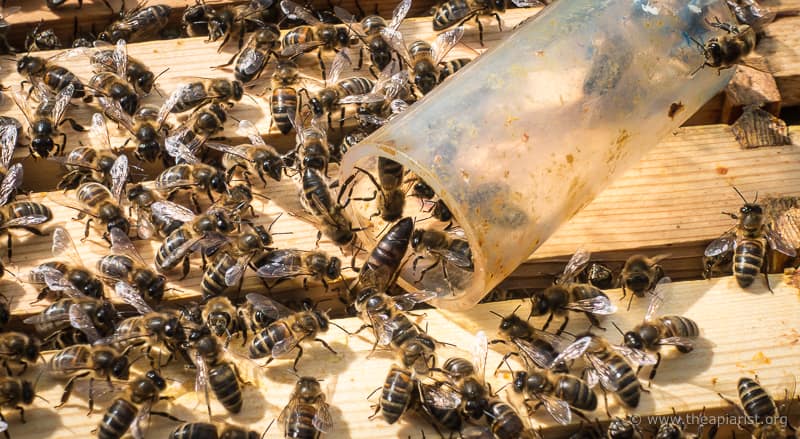


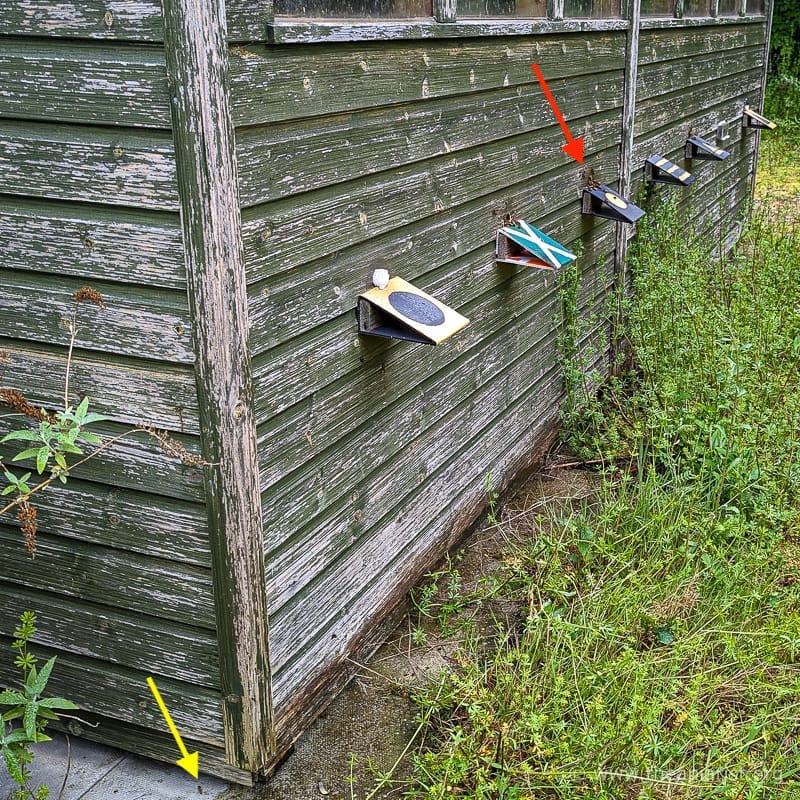
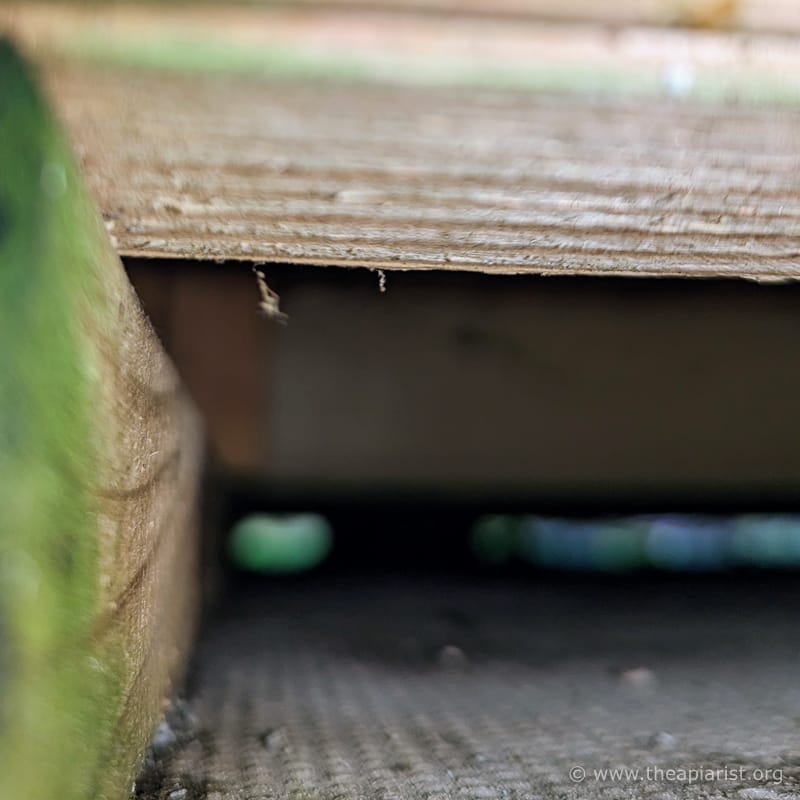
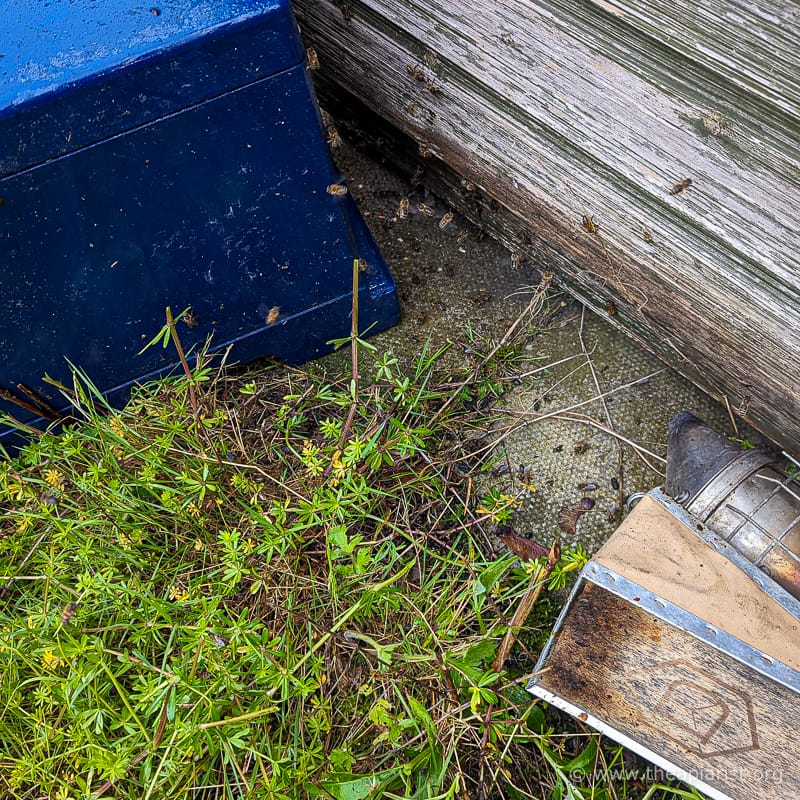
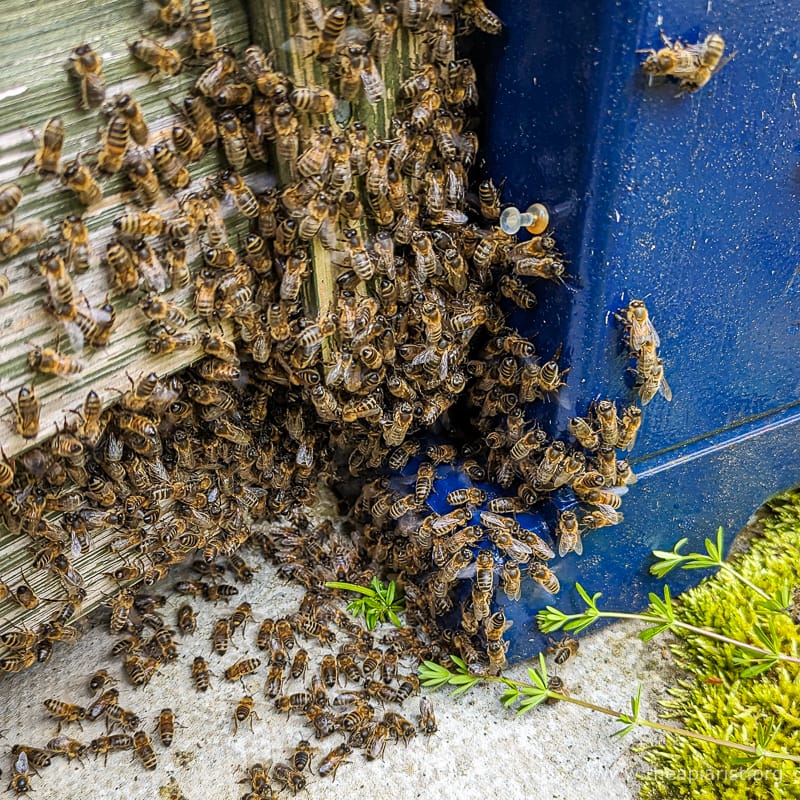
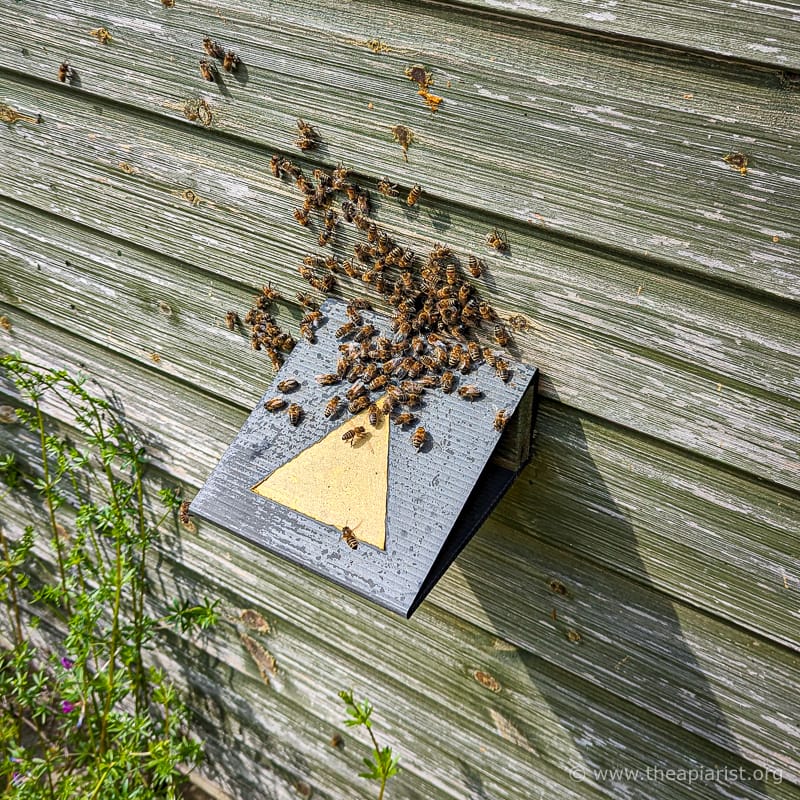
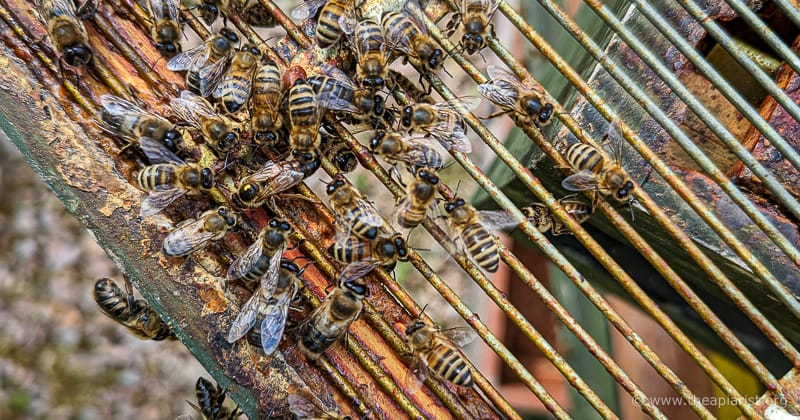
Join the discussion ...